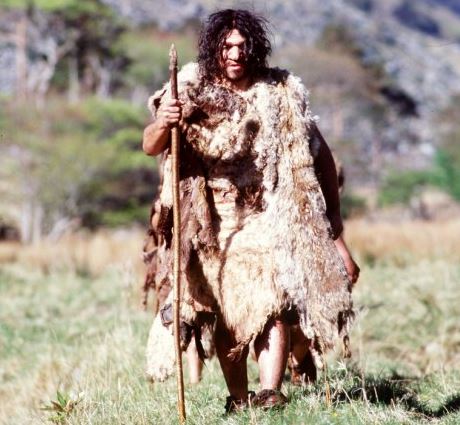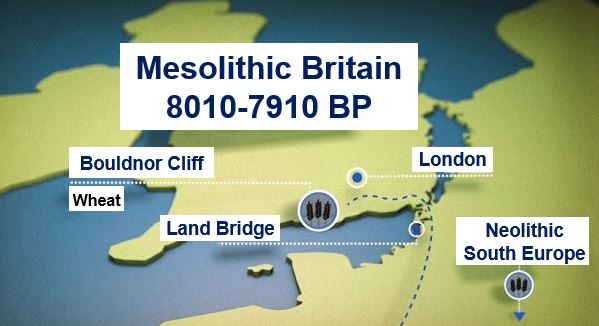Ancient Britain was not isolated and cut off from mainland Europe 8,000 years ago, as previously thought, researchers from the Universities of Warwick, Birmingham, St. Andrews and Bradford discovered.
In fact, ancient Britons were probably eating wheat 2,000 years before farming started in the island. According to their findings, wheat that was already ground into flour was being used in Britain about 6000 BC.
The researchers found evidence of several different types of wheat at an underwater archaeological site off the coast of England, dating back to two thousand years before farming had started in the British isles.

Ancient Britons 8,000 years ago were not just isolated hunter gatherers. It appears they were also traders and interacted with mainland Europe.
Most anthropologists point to farming as a defining moment for nearly all ancient human communities, saying that the milestone led to the development of societies that underpin the modern world.
In this latest study, which has been published in the journal Science (citation below), the researchers suggest that the evidence of wheat reaching the site probably means that Mesolithic Britons maintained social and trade networks spreading across Europe.
It is also possible that there may have been land bridges that connected the south east coast of Britain with the continent, thus facilitating exchanges between British hunters and southern European farmers.
The site, called Bouldnor Cliff, is a submerged prehistoric settlement in the Solent. It dates from the Mesolithic era and is in about 11 meters (12 yards) of water just offshore of the village of Bouldnor on the Isle of Wight.
At the site, the researchers found Einkorn, a type of wheat that was common in Southern Europe. The Einkorn DNA was gathered from sediment that had previously formed on the land surface, which was later submerged as glaciers melted.

The researchers say the wheat was brought to ancient Britain by neolithic traders from southern Europe. At the time, the island was much closer to the mainland. (Image source: University of Warwick)
The research was carried out by study-leader Dr. Robin Allaby of the University of York, and co-leads Professor Mark Pallen of Warwick Medical School and Professor Vincent Gaffney of the University of Bradford. Scientists from the Universities of Birmingham and St. Andrews were also involved.
Dr. Allaby suggests Mesolithic Britain was less insular than previously thought, following the Einkorn discovery. He is convinced that ancient Britons at the time were interacting with Neolithic southern European.
Dr. Allaby said:
“8,000 years ago the people of mainland Britain were leading a hunter-gatherer existence, whilst at the same time in southern Europeans farming was gradually spreading across Europe.”
“Common throughout Neolithic Southern Europe, einkorn is not found elsewhere in Britain until 2,000 years after the samples found at Bouldnor Cliff. For the einkorn to have reached this site there needs to have been contact between Mesolithic Britons and Neolithic farmers far across Europe.”
“The land bridges provide a plausible facilitation of this contact. As such, far from being insular Mesolithic Britain was culturally and possibly physically connected to Europe. The role of these simple British hunting societies, in many senses, puts them at the beginning of the introduction of farming and, ultimately, the changes in the economy that lead to the modern world.”
“The novel ancient DNA approach we used gave us a jump in sensitivity allowing us to find many of the components of this ancient landscape.”
Prof. Gaffney believes this find will start a new chapter in British and European history. Thanks to genetic analyses, archaeologists and scientists today can gather evidence preserved deep within the sediments of the lost prehistoric landscapes and make discoveries.

It is now evidently clear that ancient Britons 8,000 years ago were not completely isolated from the mainland, says Dr. Allaby.
Prof. Gaffney said:
“The use of ancient DNA from sediments also opens the door to new research on the older landscapes off the British Isles and coastal shelves across the world.”
Prof. Pallen, leader of the Pallen Group at the University of Warwick’s Medical School, said:
“We chose to use a metagenomics approach in this research even though this has not commonly been used for environmental and ancient DNA research.”
“This means we extracted and sequenced the entire DNA in the sample, rather than targeted organism-specific barcode sequences. From this we then homed in on the organisms of interest only when analyzing DNA sequences.”
Citation: “Sedimentary DNA from a submerged site reveals wheat in the British Isles 8000 years ago,” Oliver Smith, Garry Momber, Richard Bates, Paul Garwood, Simon Fitch, Mark Pallen, Vincent Gaffney & Robin G. Allaby. Science. February 27, 2015. DOI: 10.1126/science.1261278.
Warwick University Video – Britain & Europe 8000 Years Ago
